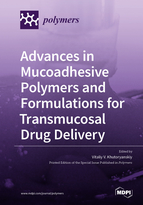Advances in Mucoadhesive Polymers and Formulations for Transmucosal Drug Delivery
A special issue of Polymers (ISSN 2073-4360).
Deadline for manuscript submissions: closed (15 January 2018) | Viewed by 85108
Special Issue Editor
Interests: water-soluble polymers; hydrogels; polymer complexes; drug delivery; mucoadhesion; nanomaterials
Special Issues, Collections and Topics in MDPI journals
Special Issue Information
Dear Colleagues,
It is my pleasure to invite you to contribute to this Special Issue focused on the advances in mucoadhesive polymers and formulations. Mucoadhesion, defined as the ability of materials to stick to mucosal tissues in the human body, has attracted substantial interest over the last few decades. The number of publications reporting the use of various polymeric systems for designing various dosage forms for transmucosal drug delivery is growing continuously. There is also a strong interest in mucoadhesion in food, dental care and cosmetic formulations. Mucoadhesive formulations reported so far range from simple use of water-soluble polymers or their mixtures to functionalised materials bearing specific “adhesive” chemical moieties. The aim of this Special Issue is to present recent advances in the area of mucoadhesive polymers and formulations.
This Special Issue invites original papers and reviews reporting on recent progress in the following areas:
· Design of novel mucoadhesive polymers
· Formulation of polymeric dosage forms for transmucosal drug delivery
· Methods of in vitro and in vivo testing of mucoadhesive dosage forms
· Studies of mucoadhesive interactions involving polymers
Prof. Vitaliy Khutoryanskiy
Guest Editor
Manuscript Submission Information
Manuscripts should be submitted online at www.mdpi.com by registering and logging in to this website. Once you are registered, click here to go to the submission form. Manuscripts can be submitted until the deadline. All submissions that pass pre-check are peer-reviewed. Accepted papers will be published continuously in the journal (as soon as accepted) and will be listed together on the special issue website. Research articles, review articles as well as short communications are invited. For planned papers, a title and short abstract (about 100 words) can be sent to the Editorial Office for announcement on this website.
Submitted manuscripts should not have been published previously, nor be under consideration for publication elsewhere (except conference proceedings papers). All manuscripts are thoroughly refereed through a single-blind peer-review process. A guide for authors and other relevant information for submission of manuscripts is available on the Instructions for Authors page. Polymers is an international peer-reviewed open access semimonthly journal published by MDPI.
Please visit the Instructions for Authors page before submitting a manuscript. The Article Processing Charge (APC) for publication in this open access journal is 2700 CHF (Swiss Francs). Submitted papers should be well formatted and use good English. Authors may use MDPI's English editing service prior to publication or during author revisions.
Keywords
- Mucoadhesion
- Mucosal membranes
- Mucoadhesive polymers
- Transmucosal drug delivery
- Mucins
- Thiols
- Retention







